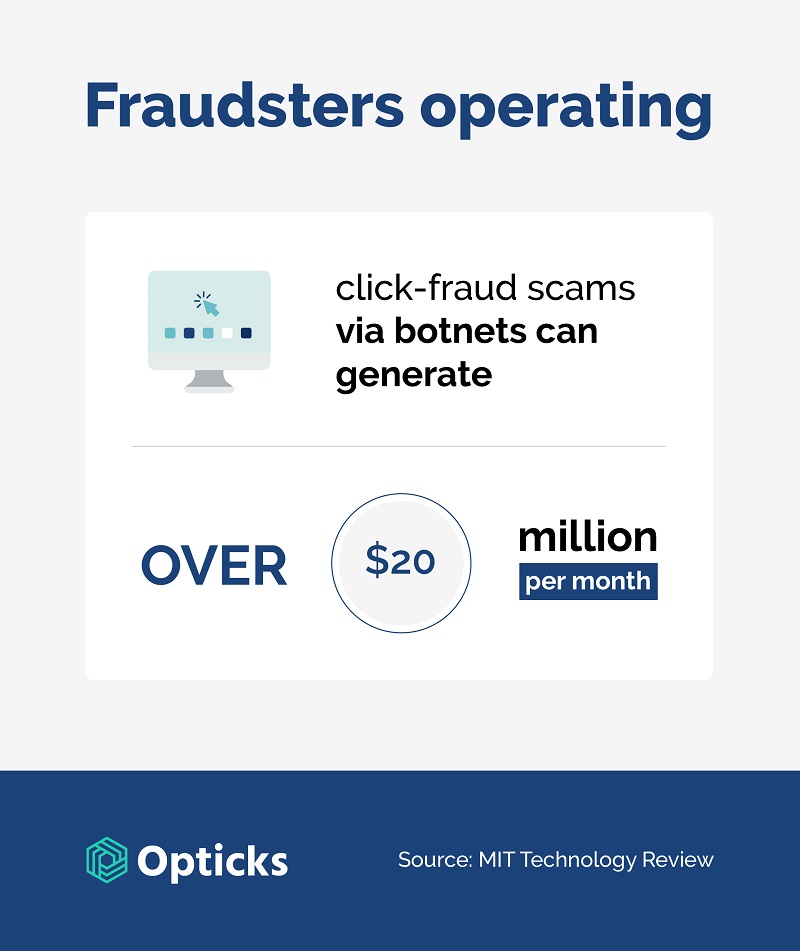Ad fraud is a multi-layered problem. From click farms and cookie stuffing to ad injections and botnets, the list of ad fraud methods is as long as your arm — and that list is growing every day.
Though there are multiple types of ad fraud, it’s often used as a catch-all term for all fraudulent behavior that affects the marketing and advertising industry. However, you should know how each ad fraud technique affects your organization and what you can do to prevent it.
Here, we discuss the prevalence of botnets and click fraud botnet scams, one of the most difficult types of ad fraud to detect and prevent. Fraudsters operating click fraud scams via botnets can generate over $20 million per month — which is money taken straight from your pocket. We’ll explore how the murky presence of botnets is contributing to the rise in ad fraud, and what you can do to stop it in its tracks.
How do botnets work?
Botnets are a collection of multiple, malware-infected devices that are connected and controlled by fraudsters. Often, these are groups of remote devices that are connected by a common piece of code and operated by remote threat actors.
The goal of botnet creation is to infect as many connected devices as possible and use them for automated tasks. Users are often completely unaware that their devices are infected.
In addition to being created by infecting thousands of devices, we also see evidence of botnets being generated by virtualizing devices in the cloud, or by creating fake traffic from datacenters disguised as devices.
Click fraud botnet scams: What’s the impact?
Botnets can be used to carry out several shady tasks, including ad fraud.
Using infected devices, botnets partially override web browsers to divert fraudulent traffic to ‘click’ on online ads. Botnets will only control small parts of web browsers to avoid detection. However, with thousands of devices infected, even a small amount of diverted traffic to online ads from each device soon adds up to a huge quantity of fake clicks. With every fraudulent click, scammers are draining money from advertising fees.
Here are just a couple of examples of ad fraud botnets that demonstrate the intensity of their impact:
- 3ve, a huge ad fraud botnet, generated between 3 and 12 billion daily ad bid requests, and cost publishers $29 million for ads that no real users ever saw.
- Methbot, a Russian-based botnet, stole $180 million in online ad revenue by generating around 300 million fraudulent clicks per day.

Botnet traffic has many of the same characteristics as human traffic, making it very difficult to detect without the right technology. As hundreds or thousands of clicks from just one device would be detected and blocked immediately, botnets can hide behind each individual IP address to mimic individual users.
Botnets are not only a grave threat to ad campaigns and their associated budgets but also to organizations’ ability to make sound decisions because of flawed and unclean data.
How to ensure botnet prevention and protection
Botnet prevention and removal is a highly complex task. Their self-propagating nature and the fact that they can disguise themselves as authentic and legitimate traffic sources makes it impossible for regular technology to step up to the plate.
Botnets are so advanced that they can break through passwords and security questions with minimal effort, which is why digital businesses must arm themselves with a tool that’s built specifically for detecting botnets and other types of ad fraud.
Here’s how Opticks protects against botnets:
- When botnets are using infected or hijacked devices, we quickly identify background processes where the ad has not been seen by the user — yet impressions, clicks, or leads will count towards the advertisers’ budget.
- Botnets are detected the same way bots are: due to their “automated” nature of operations.
- Preventing traffic from malware APKs: Opticks creates lists that users can use to prevent such traffic.
Stop botnets in their tracks and protect your ad campaigns
Each year, millions of dollars are collected by fraudsters while your campaigns languish. Unfortunately, every time one botnet is taken down, another will spring up in its place.
You already know that preventing ad fraud is important. But attempting to prevent ad fraud manually is not an effective, nor a scalable solution. Click fraud botnet operations are too sophisticated and insidious to be taken down by blacklists or protected against with passwords.
Using anti ad-fraud software is the only secure way to ensure botnet prevention in real time. To learn how Opticks can protect your organization from the impact of botnets, contact our expert team for a demo.
